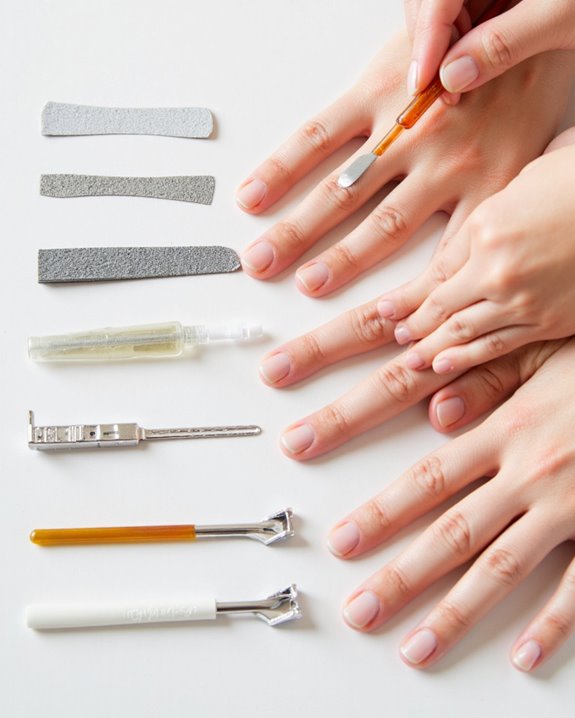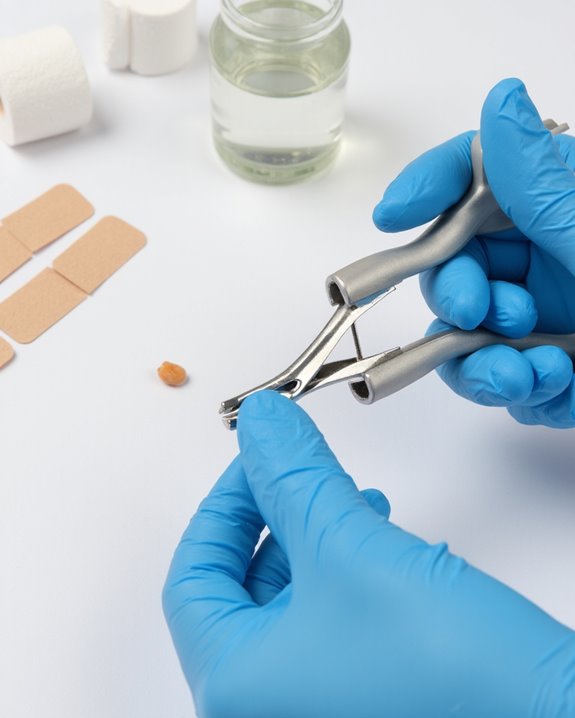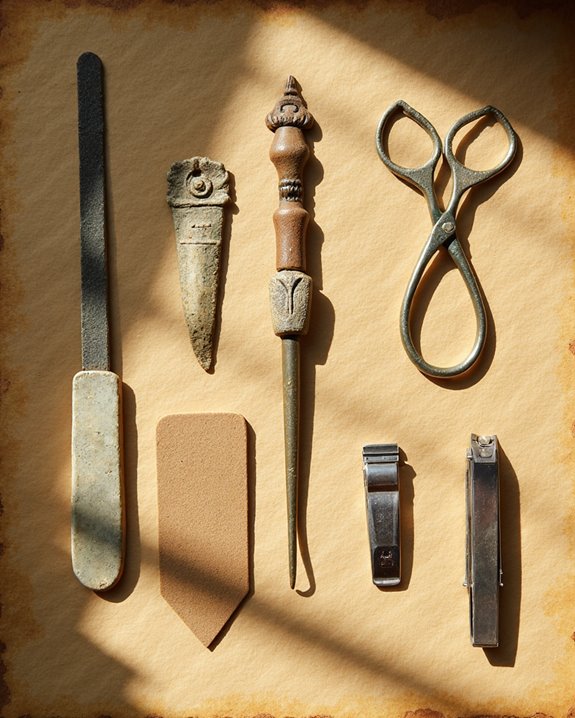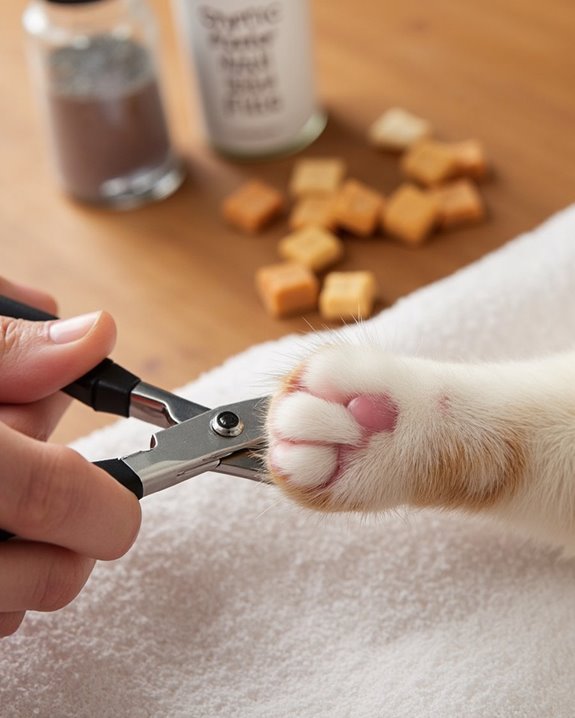To cut nails without clippers, I recommend seven simple steps: First, soak your nails in warm water for 10-15 minutes to soften them. Second, dry thoroughly to improve grip. Third, use sharp nail scissors to cut straight across. Fourth, file in one direction at a 45-degree angle. Fifth, try the fold-and-break method for emergencies. Sixth, smooth edges with a fine-grit emery board. Seventh, apply moisturizer to seal and protect. These techniques promote healthy nail maintenance without specialized tools.
Key Takeaways
- Soak nails in hot water for 10-15 minutes to soften them before attempting any clipper-free methods.
- Trim using high-quality scissors with sharp, straight blades for precision cutting across the nail.
- Try the fold-and-break method by creating a central crease after soaking and gently working from edges to center.
- Use a glass nail file at a 45-degree angle, filing in one direction to safely reduce length without clippers.
- Apply ceramide-rich moisturizer after trimming to seal in moisture and prevent nail splitting or cracking.
Preparing Your Nails for Clipper-Free Trimming
When you’re without nail clippers, proper preparation becomes essential for successful manual nail trimming. I recommend starting by soaking your nails in hot water for 10-15 minutes, which softens them greatly and makes them more pliable for clipper-free techniques. Alternatively, you can use your shower time to expose your fingernails to moisture, helping prevent painful splits when you cut your nails manually. Using the appropriate nail file grit ensures a smoother finish and reduces the risk of nail damage. Before attempting to trim your nails without nail clippers, make sure you’ve cleaned them thoroughly with soap and water, removing any debris that could cause infection. After soaking, dry your nails gently but thoroughly to improve grip during the trimming process. For ideal nail care and safety, aim to maintain approximately 5mm of length before trimming, which leaves about 2mm of white nail for protection.
Using Scissors as an Alternative Tool
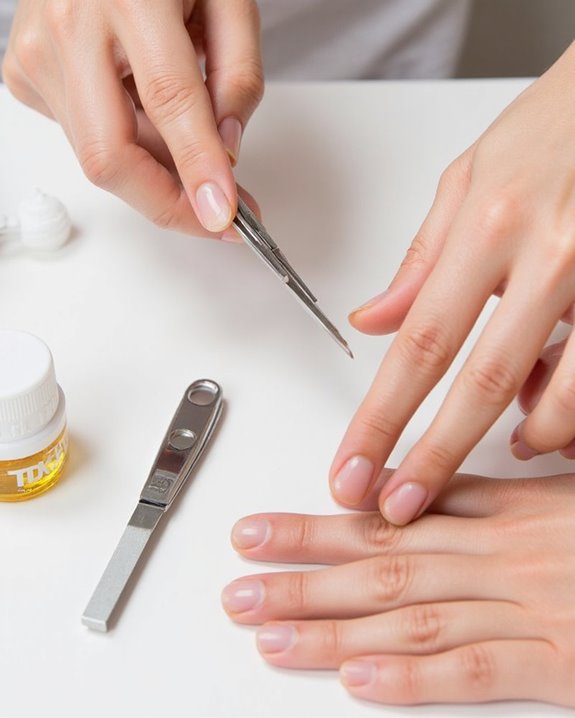
After softening your nails through soaking, you’ll be ready to look at the most common clipper alternative: scissors. I recommend selecting high-quality nail scissors with sharp, straight blades for this task, as they’ll provide the precision you need for safe trimming. A small Swiss Army knife that includes scissors can work remarkably well in a pinch.
When using scissors to cut your nails, hold the scissors firmly but not too tightly, and trim straight across in one confident motion. For thicker nails, you’ll need to apply more pressure while maintaining control. After completing the initial cut, I suggest taking a nail file to trim and shape the edges, creating a smooth finish that prevents snagging and splitting. This scissors-and-file combination guarantees your nails look neat without requiring traditional clippers.
The Fold and Break Method
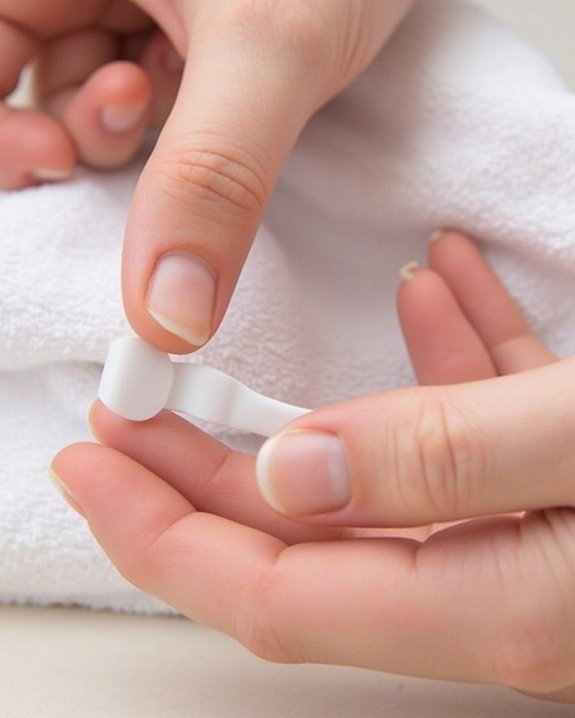
The fold and break method offers a surprising solution for nail trimming when clippers aren’t available. I recommend starting by soaking your fingernails and toenails in warm water for 10-15 minutes, which softens them and makes cutting nails safer. Next, create a central crease by gently moving the nail back and forth, then gradually work toward the edges to initiate a natural break.
To trim your fingernails effectively, fold the white portion repeatedly until it breaks cleanly, maintaining a 2mm white edge to prevent pain. Take your time with this process, allowing the break to progress from the edges to the center, which minimizes rough edges. This technique requires patience but produces excellent results when shape your nails without tools, typically taking more time than conventional methods but leaving healthier nails without jagged edges.
Filing Techniques for Shaping and Shortening
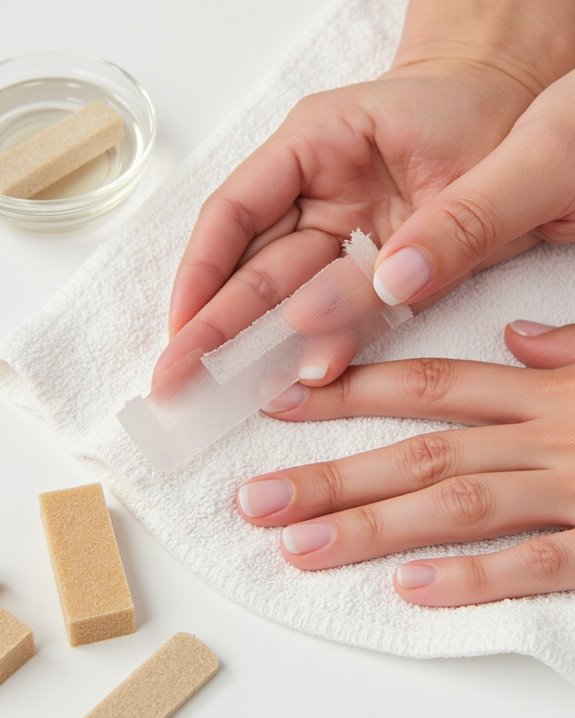
Beyond the fold and break method, I’ve found that filing offers another excellent approach for maintaining your nails without clippers. When using a nail file, hold it at a 45-degree angle to gain precise control as you work. I recommend starting with a coarser grit (80-100) if you need to trim substantial length, then switching to finer grit (220 or higher) for finishing. Using a high-quality glass nail file can help seal the nail edges and prevent splitting, making your nails healthier and more durable. To shape your nails, use a nail file to move in one direction from the sides toward the center, which helps keep your nails straight and prevents splitting. The consistent strokes allow you to cut straight edges or create rounded shapes, depending on your preference. When trimming your nails this way, gentle pressure and patience transform your nails to make them both shorter and beautifully shaped.
Safe Manual Breaking Techniques
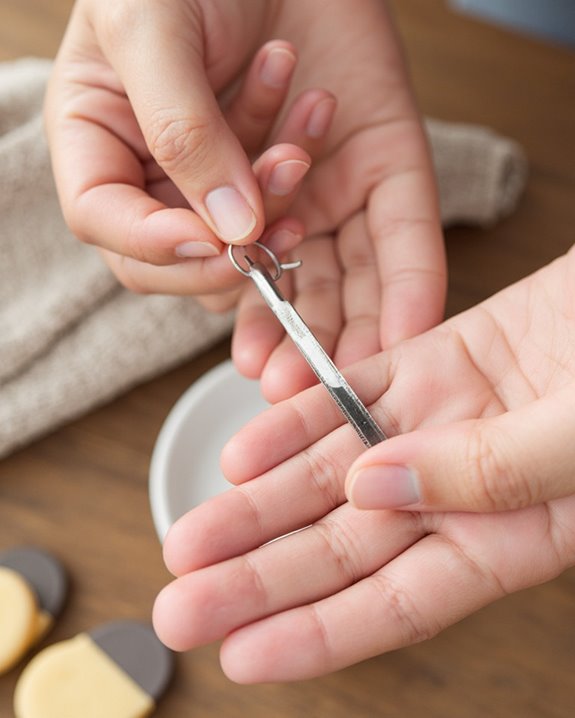
When standard nail clippers aren’t available, I’ve discovered that properly executed manual breaking techniques can effectively trim your nails without causing damage. To protect the Right Nail structure, start by gently pushing them back at the fold line, working from the center outward. Cuticles protect the nail root, so keep your nails safe by folding along the white portion, repeatedly bending back and forth until a natural crease forms. As your nails grow, you’ll need to maintain them, so master this technique of using your thumb and index finger to tear along the curved line parallel to the pink area. Leave your cuticles alone during this process, as they safeguard against infection. In emergency situations, your eye teeth can create a precise break point, resulting in smoother edges as they naturally wear down. Using the right nail file after breaking can help refine the shape and smooth any rough edges for a clean finish.
Post-Trimming Care and Smoothing
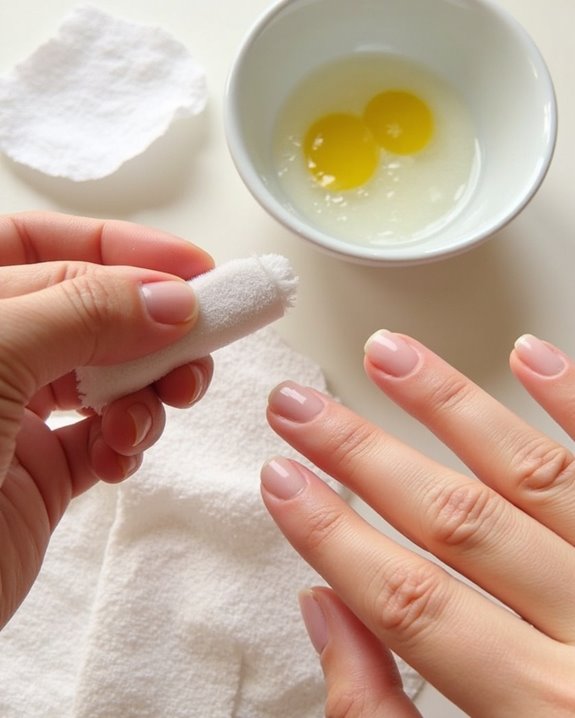
After breaking your nails manually, proper finishing touches will transform those raw edges into smooth, healthy nail tips. I recommend using a fine-grit emery board instead of fingernail clippers, applying gentle strokes in one direction from the sides toward the center. Unlike when you cut fingernails with a fingernail clipper, this technique prevents weakening and splitting.
Next, file at a 45-degree angle to eliminate jagged edges that might snag. Though you won’t have nail clippings like when using clippers or little scissors, you’ll still need to finish the job properly. Apply a ceramide-rich moisturizer immediately after filing, but avoid disturbing your cuticles. For maintenance between manicures, I suggest daily filing with olive oil on a soft cloth, which seals in moisture without the need to clip your nails as frequently.
Preventing Damage During Emergency Trimming
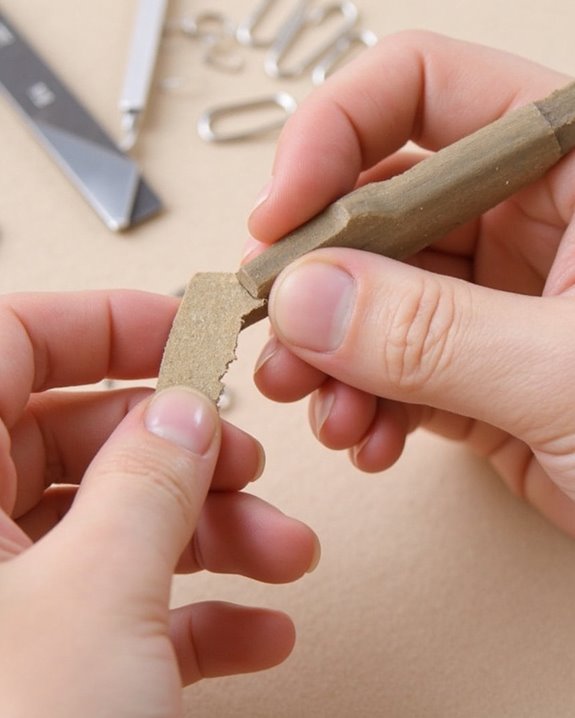
Emergency nail trimming demands careful preparation to protect your nail beds from harm. When you need to trim your nails without proper clippers, you’re less likely to cause damage if you first soak them in warm water for 10-15 minutes, which softens them considerably. This is especially important for toe nails, which are typically thicker than fingernails and would normally require toenail clippers to cut effectively.
Always sterilize whatever tool you’ll use with disinfectant, maintaining a 2mm buffer of white nail to avoid pain or bleeding. When breaking nails by folding, work from edges to center using gentle, controlled motions. You’ll be able to keep your nails healthy by immediately filing rough edges with fine sandpaper afterward, eliminating any need to worry about snags or further damage.
Frequently Asked Questions
How to Cut Your Nails Without Clippers?
I once danced on broken glass—nail safety’s similar! I’d soak nails in warm water, then use scissors cutting straight across. Filing with sandpaper avoids pain and guarantees hygiene, saving time and money too.
What Can You Use Instead of a Nail Cutter?
I’ve found several alternatives to nail cutters that prioritize safety and cater to user preferences. From durable pocket knives to portable scissors, each option offers different cost, hygiene factors, material quality, eco impacts, and longevity effects.
How Did People Cut Nails Before Nail Clippers?
You’re wondering about ancient methods? I’ve studied how traditional ways of nail cutting relied on indigenous methods. Before nail clippers, I’d use scissors, bite them, tear with hands, or carefully use knives—prehistoric grooming at its finest!
How to Cut Nails Step by Step?
I’d start by preparing warm water to soften my nails. I’ll hold each finger safely, cut at a straight angle, then file in one direction. Good hygiene practices and routine maintenance are key for healthy nails.

